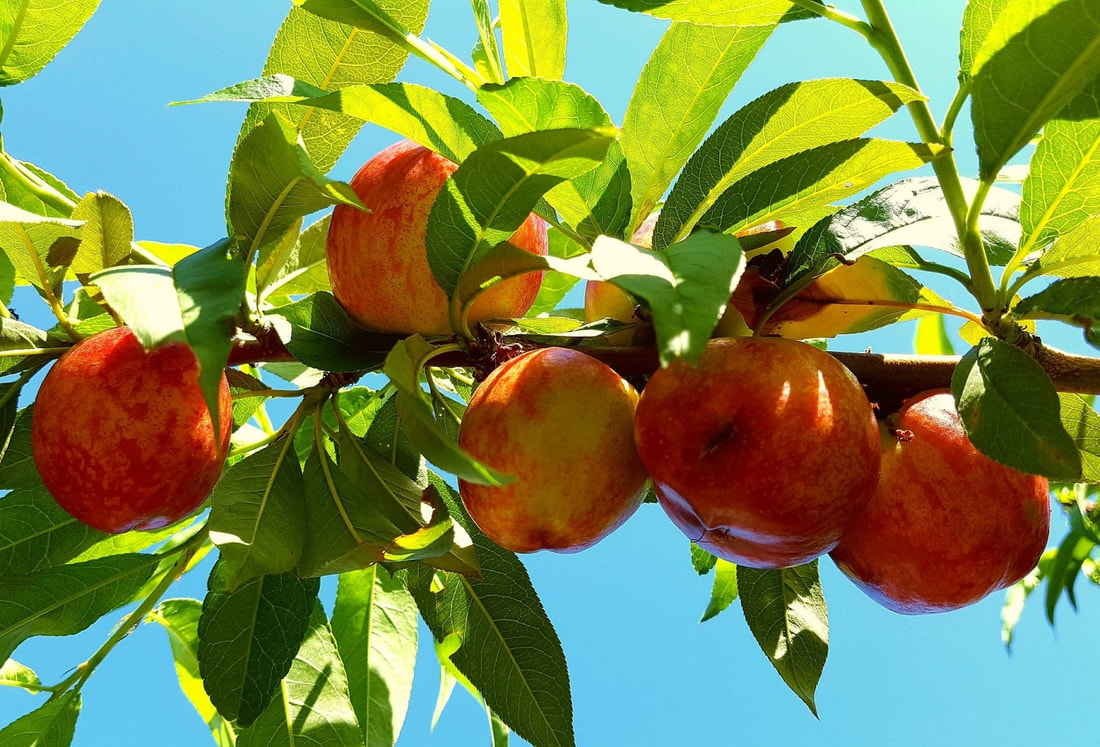|
I keep hearing from cellar bin
The rumbling sound Of load on load of apples coming in For I have had too much Of apple-picking: I am overtired Of the great harvest I myself desired. By Robert Frost You stretch your hand and pick a fruit off the branch, still warm from the sun. You plunge your teeth into a soft and juicy flesh... the fruit that hasn't been sprayed with chemicals or treated for long term preservation, spent days in the back of a truck or a few months in the fridge... is it possible? Yes, it is. If you grow it yourself. You can grow fruit trees even in a small backyard and it's not as hard as it looks. There are only a few small tricks that you really need to know and we are going to go through them turn by turn. What do you need to grow fruit trees Fruit trees require at least six hours of full sun and they don't like strong winds. The best place for them is in a sheltered sunny spot. If you are lacking one, try to grow currants (black, white or red), tamarillo or cherry guava as they don't require as much sun. They also need good drainage and room to grow. The required space between trees is usually specified in the label attached to the plant; if unsure, consult the nursery. Usually, it is three metres between trees, and, as most of us are probably not the owners of the biggest backyard, a dwarf fruit tree is going to be the best option. Another important point to consider is whether the tree you are about to plant is self – fertile or needs a cross – pollinator. Fruits like, nectarines, citrus, peach and apricots don't need a pollinating neighbour (meaning, they will bear fruits on their own). Cherries, apples, pears and plums need a pollinator. If you don't have enough space, you still can plant a desired tree as the pollinator can grow at your neighbour's backyard or it could be a tree from a slightly different family, for example: nashi pears are a pollinator for pears. If you are beginner or too busy to look after your trees, you can choose the ones that are easier to look after: figs, quince quince-antioxidant-champion.html or persimmons. Just remember, that even these varieties need to be netted against birds and possums. Also check that the tree you are about to buy is suitable to your climate and microclimate. How to choose fruit trees. Always buy the tree from a reputable supplier, with a label. Check the roots – they shouldn’t be damaged, without splits and cut neatly. Evaluate the brunches – are you be able to create the shape you’re after? How to plant fruit tree. The best time to plant fruit trees is in winter for deciduous varieties (they lose leaves during winter) as they are in a dormant state and autumn for citruses (oranges, lemons, mandarins, grapefruit, kumquat). You can also plant in spring, but then you need to buy potted trees; they are more expensive than bare – rooted and aren’t going to sprout easily either. Before planting bare-rooted ones, soak the roots in the water. With potted trees, you need to remove them from the pot and inspect the roots. If they have circled around the pot (overgrown the pot), disentangle them gently and trim some of the roots as the tree can suffocate itself when it starts to grow. Before planting your tree you need to prepare soil. The rule of a thumb: all trees hate water clogging, especially citruses. That why you need to dig a hole bigger than the roots (1 metre wide and half metre deep) and fill it with good quality compost mixed with soil; incorporate gypsum if your soil is clay. Make a little mountain with a dent in the middle - sort of like a volcano - where you are going to pant the tree. Soil that’s too sandy is a problem too (Frankston, Seaford areas). You can improve it with the same mound method; just add some clay (around 10%) on the top (25 – 35 cm) of your little mountain. Tease the roots gently to loosen then up. Spread the roots over your improved soil mix and fill the soil around the roots, the soil should be on the same level as it was in the pot and the graft union should be at least 5 cm above the soil. Check that no roots are exposed. Firm the soil around the tree and water thoroughly. Apply mulch as it keeps the tree from over – cooling during the winter and protects from over – heating during summer; mulch also improves the soil after it breaks down and decreases the amount of weeds. Just remember to not apply it too close to the tree's trunk as it can cause rot. Here is my article about mulching all-about-mulch.html How to look after your fruit trees after planting. All after – planting activities can be summarised as: watering, fertilizing, pruning, weed and pest control. Watering. It is very important to water your tree regularly, especially during the first year of establishing. Normally, 3 - 4 times a week is enough. If unsure, consult a nursery. Fertilizing. Usually, the best time to feed your tree is the end of the winter, however, sometimes it depends on the type of tree and it’s best to check in the nursery. Composted animal manure, like chicken, for example, together with blood and bone is ideal. Incorporate it around the drip line (the perimeter of canopy) otherwise you can damage the roots. Pruning is very important as it increases the harvest size, invigorates the tree and keeps it to a manageable size. Almost all trees need it done yearly. Prune your tree in summer after you collect the harvest to reduce the height and for better sun penetration. During the winter prune the overgrown, dead, broken or deceased branches; the ones that cross each other, suckers, down-growers and small ones. Also remove shoots that grow below the graft. I always take a step back during the pruning to evaluate the progress. If the shape of the tree looks evenly spaced and with a lot of light it is time to stop. The most popular shape of tree is an open vase. Trees don't like to compete with the grass within the drip line, especially during the first year. Use or destroy all the fallen fruits and also the ones that are left as mummies on the brunches in the end of the season as they are going to be the breeding point for pests. To increase the harvest you need to attract bees and beneficial insects and ward off the “bad” bugs. Plant rosemary, lavender lavender-the-royal-herb.html or oregano (oregano-pizza-herb-antioxidant-booster.html) next to your trees; they are great for these purposes. You can also incorporate alpine strawberries as bee attractors, ground cover that suppress the weeds and source of divine super–food berries (alpine-strawberry-vitamins-galore.html) To find out how to deal with pests organically please visit my post organic-pest-control.html Citruses. This family of fruit trees is slightly different and they need to be mentioned separately from the rest of the fruit trees, as they are very fussy about watering, feeding and they have slightly different pruning requirements. They need a sunny position all year around, even during the winter months. They don't like clay soil, water clogging and a salt-laden breeze. They are greedy feeders so apply fertilizer twice a year: winter and summer. If your tree doesn't look happy (or dropping fruits) apply it again. Citruses have a shallow root system, which means that:
Apart from lemons, they don't like to be pruned heavily. You can prune lemons the same way as the other fruit trees, see above. Always remove and destroy any gall wasps. Dwarf fruit trees. If you don't have a big backyard, your best option is a dwarf fruit tree. They will produce full size fruits and they are more manageable than full size trees as you can move them around as you please. You can plant it in the ground or keep in pots, they looks lovely on the patio or porch. There are the same rules about how to look after them; you'll need to give them slightly more attention as they don't have access to all nutrition and water as if they were in the soil. Don't forget to water, feed them twice a year – winter and summer and re - pot once every two years, changing the potting mix completely. The bigger the pot they are growing in, the more happier they will be. I grow as dwarfs: apples, cherry, avocado, nashi, pear, persimmon, cherry and kumquat. To save space you can also espalier the tree: train it to grow against the wall or any other flat structure, training the side brunches and cutting the ones that grow onwards. Espaliered trees are more manageable. Heritage fruit trees. The heritage or heirloom fruit tree is the one that is rare, has been growing for hundreds of years, has a unique taste and is not available in supermarkets. Sadly, a lot of them have been lost completely for cultivation. They are gone because of the profit maximisation goals of the big chain supermarkets. Superstores like Coles and Woolworth are buying from farmers only fruits that are tough, with thick skin and can be kept in the fridge for up to six months. Apple and other fruit growers were forced to cut trees that didn't fit into this scenario. How many types of apple trees do you know? Golden Delicious, Granny Smith and Gala? Did you know that old fruit catalogues contained hundreds of types of apple trees? I am growing the following heritage apple trees: Eggremont Russet, Kox Orange Pippin, Granvenstein, Five Crown, Alexander, Grand Duke Constantine, Renete Dores, Snow among others. If you decide to start a small orchard, please consider buying a heirloom tree; by doing this you are contributing and supporting bio – diversity, sustainability and contributing to preserving our heritage fruits. Conclusion. Growing your fruit trees are beneficial in all aspects: your eat great quality fruits that are substance free, spend more time in fresh air looking after them, learning something new all time and saving your money on groceries. You can use your trees as a divider of your garden or as focal point in a landscaping project. Besides, you are going to enjoy the shade during the summer, fragrance and stunning view of your blossoming garden during the spring, bright Van Gogh colours during the autumn and the effect of light streaming through the brunches during the winter making your garden enigmatic; something straight out of Swan Lake. ***
0 Comments
Your comment will be posted after it is approved.
Leave a Reply. |
Archives
February 2020
Categories |
Julia Organic Copyright 2021 Website MapMyBusiness


 RSS Feed
RSS Feed



